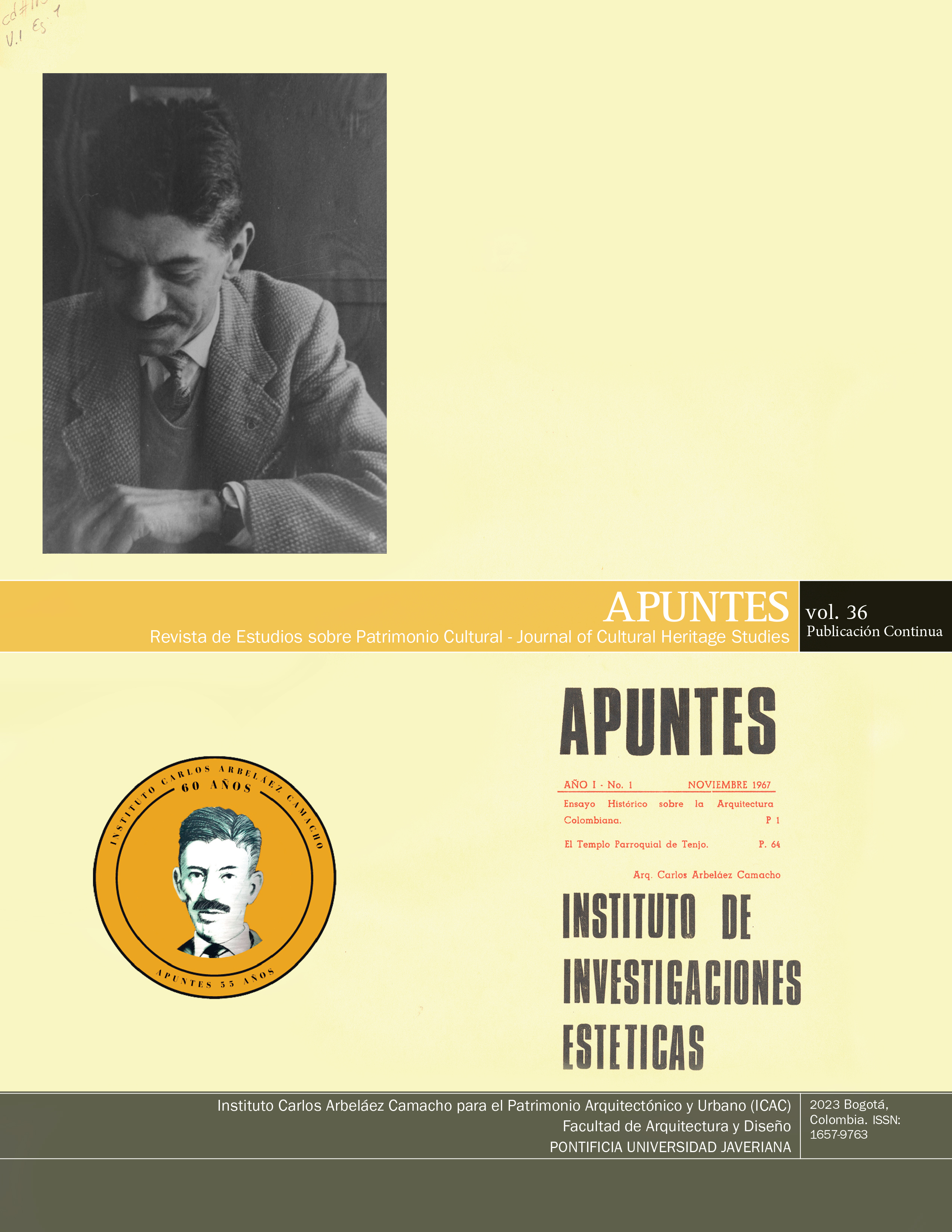Abstract
Urban gardens in neighborhoods with history contribute to their heritage image and highlight their attributes. Their historical and social values talk about sense of belonging to the plance and create link with its inhabitants. In Barrio República, located in Santiago de Chile, arises the need to identify as Cultural Landscapes the spaces located in the streets, passages and avenues. This research is based on the meaning of Cultural Landscapes according to different authors, the historiographical analysis and the development of interviews carried out throughout the process. As a result has been shown Urban gardens' relevance for local people, regardless their lifestyle, contributing in their social relationships, keeping community spirit that unites and strenghtens them.
Azkarate, A., y Azpeitia, A. (2016). Paisajes urbanos históricos. ¿Paradigma o Subterfugio? En A. Chavarria Arnau, y M. Jurkovic (Orgs.), Alla ricerca di un passato complesso. Contributi in onore di Gian Pietro Brogiolo per il suo settantesimo compleanno (pp. 219-238). IRCLAMA.
Ballester, J. M. (2005). El concepto de paisaje cultural. En M. Aguiló Alonso y R. de la Mata Gorostiza (Coords.), Paisajes culturales (pp. 21-32). Colegio de Ingenieros de Caminos, Canales y Puertos.
Brunner, K. (1930, janeiro 6). Urbanización de Santiago: el sistema de las áreas verdes. Boletín Municipal.
Cambón, E. (2009). Paisajes culturales como patrimonio: Criterios para su identificación y evaluación. Arquitectura y Urbanismo, XXX(1), 10-17.
Cambón Freire, E. del C., Rizo Aguilera, L. M., Espinosa Ocallaghan, M., Rodríguez Valdés, R., López Segrera, Y., Morales Tejeda, A. L., Prieto Lescaille, I., Ocaña Dayar, H., López Rodríguez, O., y Baños Rodríguez, Z. J. (2014). Paisajes culturales de Santiago de Cuba: valoraciones para su protección, conservación y puesta en valor. Revista Anales de la Academia de Ciencias de Cuba, 4(2), 1-20.
Canales, M. (2005). El saber cualitativo. En Metodologías de la investigación social. Introducción a los oficios (pp. 19-23). LOM Ediciones.
Centro del Patrimonio Mundial Unesco. (2005). Directrices prácticas para la aplicación de la Convención del Patrimonio Mundial. http://whc.unesco.org/en/guidelines
De Ramón, A. (1985). Estudio de una periferia urbana: Santiago de Chile 1850-1900. Historia, 20, 199-289.
De Ramón, A. (2000). Santiago de Chile (1541-1991). Historia de una sociedad urbana. Editorial Sudamericana.
II Encuentro de Cartagena de Indias. (2012). Carta Iberoamericana del Paisaje Cultural 2012. “Patrimonio”: Economía Cultural y Educación para la Paz (Mec-Edupaz), 1(7), 127-140.
Ilustre Municipalidad de Santiago. (2021). Plano Base Comunal y Ortofoto Barrio República. Sistema de información Urbana, Catastro 2021. Dirección de Obras Municipales.
Laborde, M. (2008). Parques de Santiago. Historia y patrimonio urbano. Ograma.
Lafuente, C. y Marín, A. (2008). Metodologías de la investigación en ciencias sociales: fases, fuentes y selección de técnicas. Revista EAN (64), 5-18.
Magnaghi, A. (2000). Il Progetto Locale. Bollati Boringhieri Editore.
Merino, R. (2014). Barrio República. Una crónica. Ediciones Universidad Diego Portales.
Nuñez Escudero, M., Alvarado Castro, P., y Castro Aguilera, I. (2019). Vinculaciones de los habitantes con los jardines urbanos del barrio patrimonial Matta-Sur, Santiago de Chile. Revista de Arquitectura, 24(37), 32-39. https://doi.org/10.5354/0719-5427.2019.54569
Ojeda Leal, C. (2014). Paisaje cultural y patrimonio: Fragilidad paisajística como propuesta de análisis del patrimonio y el paisaje. Urbano, 17(30), 88-95. http://revistas.ubiobio.cl/index.php/RU/article/view/212
Saavedra, M. (2004). Los grandes equipamientos, su relación con el desarrollo del barrio Sur Poniente. En VV. AA., Santiago Sur Poniente: barrio universitario, desarrollo urbano y patrimonio (pp. 56-65). Dirección de Obras Municipales de Santiago.
Sautu, R, Boniolo, P, Dalle, P y Elbert, R. (2005). Los supuestos de la investigación cuantitativa y cualitativa. En Manual de metodología. Construcción de marco teórico, formulación de los objetivos y elección de la metodología (pp. 39-40). Consejo Latinoamericano de Ciencias Sociales - CLACSO.
Valles, M. (1999a). Genealogía histórica y planteamientos actuales acerca de la investigación cualitativa. En Técnicas cualitativas de la investigación social. Reflexión metodológica y práctica profesional (pp. 21-45). Editorial Síntesis.
Valles, M. (1999b). Técnicas de conversación, narración (I): La entrevista en profundidad. En Técnicas cualitativas de la investigación social. Reflexión metodológica y práctica profesional (pp. 177-234). Editorial Síntesis.
Vera y Falcó. (2004). Barrio Universitario: El nacimiento de una nueva República. http://www.periodismo.uchile.cl/themoroso/2004/5/barrios/republica.html
Vicuña Mackenna, B. (1872). La transformación de Santiago. Imprenta de la Librería del Mercurio.
Zárate, A. (2010). Paisajes culturales urbanos, un legado para conservar. Anales de Geografía, 30(2), 187-210. http://revistas.ucm.es/index.php/AGUC/article/view/AGUC1010220187A/30724
Apuntes is registered under a Creative Commons Attribution 4.0 International Public License. Thus, this work may be reproduced, distributed, and publicly shared in digital format, as long as the names of the authors and Pontificia Universidad Javeriana are acknowledged. Others are allowed to quote, adapt, transform, auto-archive, republish, and create based on this material, for any purpose (even commercial ones), provided the authorship is duly acknowledged, a link to the original work is provided, and it is specified if changes have been made. Pontificia Universidad Javeriana does not hold the rights of published works and the authors are solely responsible for the contents of their works; they keep the moral, intellectual, privacy, and publicity rights.
Approving the intervention of the work (review, copy-editing, translation, layout) and the following outreach, are granted through an use license and not through an assignment of rights. This means the journal and Pontificia Universidad Javeriana cannot be held responsible for any ethical malpractice by the authors. As a consequence of the protection granted by the use license, the journal is not required to publish recantations or modify information already published, unless the errata stems from the editorial management process. Publishing contents in this journal does not generate royalties for contributors.


